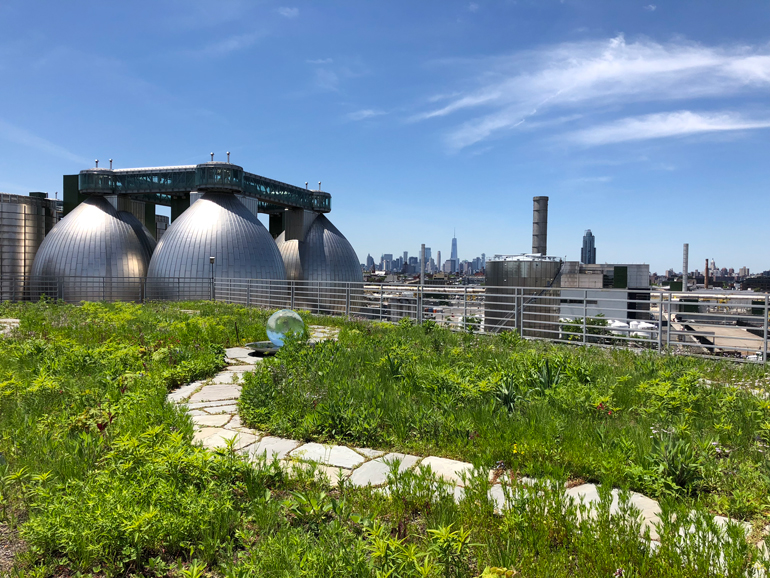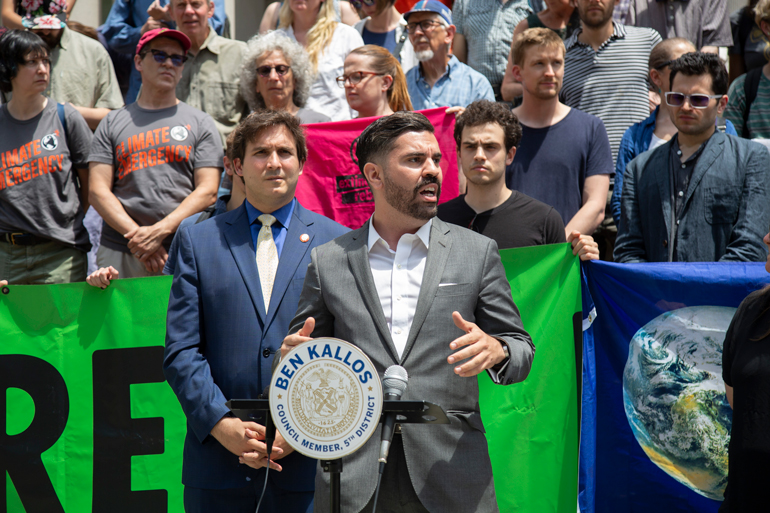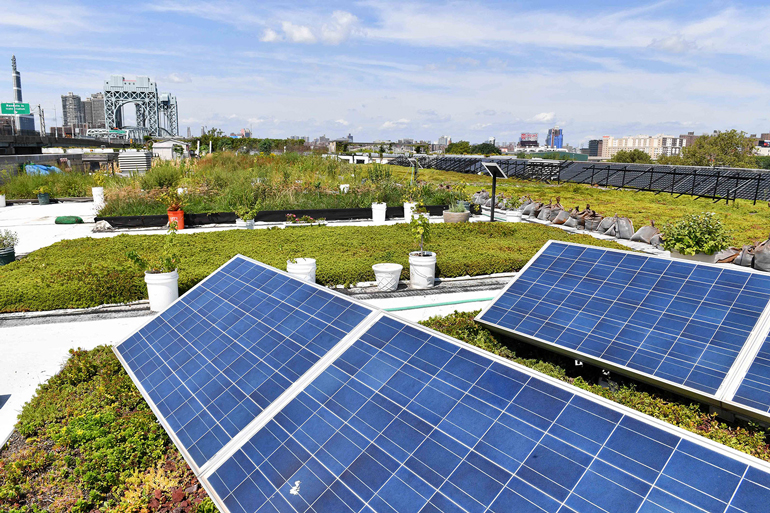
We are celebrating 15 years — and counting — of stories that are deeply researched and deeply felt, that build a historical record of what the city has been.
We are celebrating 15 years — and counting — of stories that are deeply researched and deeply felt, that build a historical record of what the city has been.
In the absence of federal climate action during the Trump administration, cities and states across the US are pushing ahead on mitigation and adaptation. Last spring, the New York City Council passed an ambitious climate legislation package focused on buildings, which are responsible for almost three quarters of all local emissions. The cornerstone of the Climate Mobilization Act, Local Law 97, focuses on improving energy efficiency and decarbonizing the energy supply in the city’s largest buildings. But the act also ventures into less familiar territory: the city’s rooftops. Local Laws 92 and 94, which went into effect on November 15, 2019, require all new buildings and major roof alterations to be capped with a green roof, solar panels, or some combination of the two.
If successful, the new policies could transform New York’s skyline. According to members of the Green Roof Researchers Alliance (GRRA), as of 2016 there were only 736 green roofs in the city, representing less than 0.1% of its buildings. But GRRA is working to change this. The 60-plus scientists, policy experts, and educators who make up the coalition have collectively spent years studying green roofs and advocating for their growth across the five boroughs. Here, GRRA members Dustin R. Partridge and Danielle Spiegel-Feld explain what New York’s new laws can mean for city residents, building owners, and birds. – SW
Why were green roofs included in the Climate Mobilization Act? What benefits do they bring in terms of climate mitigation and adaptation?
Green roofs are so important for New York City in the changing climate. They’re so important for stormwater mitigation. They’re so important for water management, which becomes increasingly crucial as rain flows become heavier in the summer. They’re so important for the urban heat island effect. They’re a critical part of our adaptation strategy, so we need to be serious about the policy.
When you think about climate change, it’s really important to start considering how you can make changes now to lessen the impact both today and in the future. Green roofs reduce the carbon footprint of existing buildings by reducing the energy used to cool and heat them. The plants up there are living materials, and they’re actually capturing carbon. But they’re also making the city more livable. Anybody that’s been in New York on a summer day knows how unbearable the heat can get; a city with green roofs is going to be less hot.
They can also help the city adapt to these extreme storm events that are happening. Without green roofs and other green infrastructure approaches, rain is just going to mix in with our raw sewage and dump out into the nearby waterways. Green roofs capture that water. They reduce the rate at which runoff is released into the sewer system, so that it doesn’t leave as one big mass of flush-out into our local waterways.
Right now, these new Local Laws seem like big changes, but the impact is going to be somewhat gradual, as they only require green roofs for new-builds or additions. Existing buildings in the city are not going to change. It is important to emphasize that these laws are not punitive. They’re for the future. It’s about developing a city that is resilient and a better place to live, not just for nature and wildlife, but also humans. I think we’re going to look back at this moment in the future and see how the laws really did make a positive impact.
How does this new legislation compare to what other cities are doing on this issue? Is New York a leader on green roof policy, or have other cities set more of a precedent?
New York City was thrust to the forefront of green roof development last year when the Green Roof Tax Abatement was updated and the Local Laws were passed. But up until that point, we were lagging behind other cities.
Toronto and Copenhagen both have mandates that green roofs be installed on new properties of a certain size. Existing properties have been a tougher nut to crack, because of the high cost of retrofitting buildings to add green roofs. But there are a number of cities, like Philadelphia and Washington DC, where property owners have stormwater management obligations. The fees they have to pay for exceeding stormwater runoff quotas can be reduced by installing green infrastructure, including green roofs. So that provides a financial incentive.
It’s almost embarrassing how far ahead Europe is. If you look at Google satellite imagery of Stuttgart, Germany, or Central London, you’ll see green roofs everywhere. Europeans have come to understand the benefits of green roofs much sooner than most people in the US, so their adoption has been quicker.
But New York City has already tried to encourage green roofs through other programs, right? How well has that worked, and how do you think the recent update might play out?
Since 2009, New York City has had a tax abatement for people who install green roofs on their buildings. It’s never been particularly widely used, and the level of funding has been quite low. Our research suggests that only seven people took advantage of the abatement between 2009 and 2017. It’s clear that, on its own, the abatement was not sufficient. There was a bill passed last summer in Albany that would extend the tax abatement, and increase the amount of money offered to buildings located in “priority areas” to up to $15 a square foot, which we hope could really move the market.
Priority areas are located in neighborhoods that don’t have green roofs now, but could really benefit from them — parts of the city that are suffering from stormwater overflow or lack of green space. Potential improvements to the bill could address issues like air pollution and heat vulnerability. It will be really nice to have a tax abatement that encourages the development of green roofs in areas that are the most vulnerable.
But the challenge is that priority areas haven’t been designated, so right now the market is pretty much at a standstill waiting to see which areas will be eligible for the higher rate. We’re really hoping that those areas will get designated quickly.
It’s important to get this tax incentive right, and to beef it up, because from a societal perspective, the benefits of green roofs far outweigh the costs. But from the perspective of any individual property owner, that’s probably not the case. It is unfair for property owners to shoulder the whole burden of cost for a societal benefit. Forcing landlords to bear this alone could also have negative effects on housing prices, to the extent that it raises the cost of construction. To me, where you have something that confers net benefits to society but not necessarily to the individual, that’s really a case for subsidization.
What parts of the city have the most green roofs today? Who currently benefits most from them?
As of 2016, almost all of the 736 green roofs in the city were in Midtown and Lower Manhattan. Green roof benefits are really concentrated. And if you look at the New York City Department of Health’s heat vulnerability map, there are swaths of the city where people are quite literally going to the hospital on a regular basis, and possibly dying, because of heat. And there are parts of the city where, every time it floods, rainwater is mixing with sewage and pouring out into nearby waterways. There are areas that could absolutely use green roofs which have historically been ignored.
The caveat, though, is that there appears to be a phenomenon whereby adding green space in traditionally disadvantaged communities increases property values — this problem of green gentrification. It was a real concern raised by potential legislative partners when they were looking at this bill, and it’s probably a valid concern.
On the other hand, the alternative is to say that neighborhoods which have historically been disinvested in, and not had an adequate share of green space — which confers so many benefits to a community — continue to be disinvested in. I don’t want to accept that the only way to avoid green gentrification is to maintain the inequitable distribution of green space in the city. But I don’t know what the alternative is. That’s still a big question.
How are owners and developers thinking about these new laws? For builders who haven’t worked with green roofs in the past, are there ways to reduce the learning curve, and the expenses involved?
The best thing that a builder–developer can do is get an engineer and green roof professional involved early in the process. You must have the building designed to hold the weight of a green roof or solar panels. Another thing to emphasize is that I wouldn’t recommend trying to install your own green roof. It’s important to have a green roof professional on board, somebody that’s established and knows what they’re doing. All those questions that individual owners have — “What if it’s too windy?” or “Won’t a green roof leak?”— can be handled by a green roof installer. It’s not that expensive if you bring them in early.
And a maintenance plan is very useful. It’s important to hire someone that will regularly maintain the green roof as they’ve designed it for the first two or three years, followed by once a month per growing season after that. If you install a roof that functions as a well-used garden or park-like area, that’s going to involve more maintenance.
The Local Laws allow builders to choose between solar panels and green roofs. Can you talk about the relationship between the two? Are there conflicts between these options, or can they work together?
It’s unclear the extent to which people will use green roofs to fulfill the mandate, as opposed to solar. There’s a whole fleet of policy incentives for solar that might make it more attractive to private building owners.
You can have a green roof with solar panels on it too, though. There are some great examples of this, like at NYC Parks’ Five Borough Complex. The plants that will grow underneath a solar panel are a little more shade tolerant, which can actually increase biodiversity in some cases. What’s also nice is that solar panels function better when they’re cooler, so having a green roof can actually enable the production of more energy on hot summer days.
People understand solar better than green roofs. Solar’s been around for years; companies are knocking on doors selling solar units. It’s an amazing way to offset your climate footprint and produce energy locally. You can know exactly how many solar panels will fit on your roof and figure out just how much energy will be produced.
Green roofs are different. Each case is different. It’s planting a garden, lawn, meadow or something on your roof that’s going to function as a living habitat. And the benefits are far more diverse than solar, which makes the sum of those benefits more difficult to understand: energy savings through reduced cooling and heating, increased stormwater capture, improved air quality, reduced noise, reduced urban heat island effect. Also, green roofs provide a habitat for pollinators, migratory birds, and other wildlife.
Can you say more about the biodiversity benefits?
By May, we’re going to have millions of birds flying through New York City. That’s mostly happening at night, and when the sun comes up they need a spot to land. Today, they’re going down on mostly impervious surfaces. Having more green roofs speckled throughout the city would provide more spots to land during the migration season, where birds can forage, find plenty of insects to refuel, and continue their flight north — or maybe find someplace to breed in New York.
So why is this important? Recent research shows that North America has lost more than a quarter of its bird population in the last 50 years, and there are a lot of reports coming out about insects disappearing across the globe. A large portion of that is due to urbanization. Whatever we can do to offset that disappearance, by installing green infrastructure or preserving habitats, can really impact wildlife conservation.
There are also exciting possibilities with native plants, although they’re still being experimented with in New York City. Green roofs are extreme conditions. Soil is very shallow, in most cases. It’s very windy, hot and dry. Not all plants can survive up there. But there are some great examples of green roofs with native plants. Kingsland Wildflowers at Broadway Stages in Greenpoint has a beautiful green roof planted almost entirely with native species from New York. There’s a beautiful wildflower meadow.
Do you have a favorite green roof in the city?
The Javits Center installed a seven-acre green roof in 2014. That’s a roof where a lot of people would have said, “Okay, forget it,” due to structural restrictions. But they went with a super-shallow growing medium that doesn’t weigh too much. The impact has been tremendous. They’ve been really open to scientific research, which has helped move the city forward on green roof issues as a whole, because it’s a building we actually have scientific data for. We can demonstrate the benefits from this installation. For example, one of the GRRA members, Franco Montalto from Drexel University, found that the green roof captures up to an average of 79 percent of rainfall during summer rain events. Their sustainability report is online, and it’s an amazing resource for understanding the environmental benefits of the green roof, but also how it’s reshaped the image of the Javits Center into this icon of sustainability.
And there’s a private roof in Little Italy that is just phenomenal. It has a bunch of native plants, trees, and nesting birds. It has prickly pear cacti. You go up there and you feel like you’re in the middle of a meadow in some parts of the roof, and in a little patch of forest in others. Lots of migratory birds move through. I always like to sit up on the roof and look at migrating warblers that are passing through the city.
As an ecologist, I always thought I would be working out in the jungle somewhere, and now I’m doing research on green roofs in New York — an entirely different kind of jungle.
The views expressed here are those of the authors only and do not reflect the position of The Architectural League of New York.



Comments